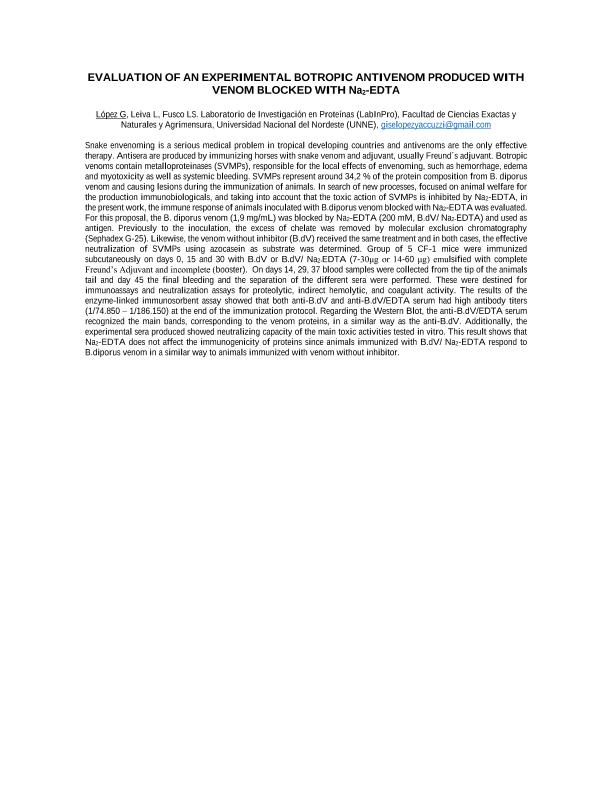Mostrar el registro sencillo del ítem
dc.contributor.author
López, Gisela Lumila

dc.contributor.author
Leiva, Laura Cristina Ana

dc.contributor.author
Fusco, Luciano Sebastian

dc.date.available
2024-01-26T13:19:41Z
dc.date.issued
2023
dc.identifier.citation
Evaluation of an experimental botropic antivenom produced with venom blocked with Na2-EDTA; XXIII Annual Meeting of the Argentinean Biology Society; Buenos Aires; Argentina; 2022; 1-1
dc.identifier.issn
0327-9545
dc.identifier.uri
http://hdl.handle.net/11336/224955
dc.description.abstract
Snake envenoming is a serious medical problem in tropical developing countries and antivenoms are the only effective therapy. Antisera are produced by immunizing horses with snake venom and adjuvant, usually Freund´s adjuvant. Botropic venoms contain metalloproteinases (SVMPs), responsible for the local effects of envenoming, such as hemorrhage, edema and myotoxicity as well as systemic bleeding. SVMPs represent around 34,2 % of the protein composition from B. diporus venom and causing lesions during the immunization of animals. In search of new processes, focused on animal welfare for the production immunobiologicals, and taking into account that the toxic action of SVMPs is inhibited by Na2-EDTA, in the present work, the immune response of animals inoculated with B.diporus venom blocked with Na2-EDTA was evaluated. For this proposal, the B. diporus venom (1,9 mg/mL) was blocked by Na2-EDTA (200 mM, B.dV/ Na2-EDTA) and used as antigen. Previously to the inoculation, the excess of chelate was removed by molecular exclusion chromatography (Sephadex G-25). Likewise, the venom without inhibitor (B.dV) received the same treatment and in both cases, the effective neutralization of SVMPs using azocasein as substrate was determined. Group of 5 CF-1 mice were immunized subcutaneously on days 0, 15 and 30 with B.dV or B.dV/ Na2-EDTA (7-30μg or 14-60 μg) emulsified with complete Freund?s Adjuvant and incomplete (booster). On days 14, 29, 37 blood samples were collected from the tip of the animals tail and day 45 the final bleeding and the separation of the different sera were performed. These were destined for immunoassays and neutralization assays for proteolytic, indirect hemolytic, and coagulant activity. The results of the enzyme-linked immunosorbent assay showed that both anti-B.dV and anti-B.dV/EDTA serum had high antibody titers (1/74.850 ? 1/186.150) at the end of the immunization protocol. Regarding the Western Blot, the anti-B.dV/EDTA serum recognized the main bands, corresponding to the venom proteins, in a similar way as the anti-B.dV. Additionally, the experimental sera produced showed neutralizing capacity of the main toxic activities tested in vitro. This result shows that Na2-EDTA does not affect the immunogenicity of proteins since animals immunized with B.dV/ Na2-EDTA respond to B.diporus venom in a similar way to animals immunized with venom without inhibitor.
dc.format
application/pdf
dc.language.iso
eng
dc.publisher
Tech Science Press

dc.rights
info:eu-repo/semantics/openAccess
dc.rights.uri
https://creativecommons.org/licenses/by-nc-sa/2.5/ar/
dc.subject
Na2EDTA
dc.subject
ANTIVENOM
dc.subject
ANTIBODY
dc.subject.classification
Bioquímica y Biología Molecular

dc.subject.classification
Ciencias Biológicas

dc.subject.classification
CIENCIAS NATURALES Y EXACTAS

dc.title
Evaluation of an experimental botropic antivenom produced with venom blocked with Na2-EDTA
dc.type
info:eu-repo/semantics/publishedVersion
dc.type
info:eu-repo/semantics/conferenceObject
dc.type
info:ar-repo/semantics/documento de conferencia
dc.date.updated
2023-09-15T12:32:57Z
dc.identifier.eissn
1667-5746
dc.journal.pagination
1-1
dc.journal.pais
Argentina

dc.journal.ciudad
Mendoza
dc.description.fil
Fil: López, Gisela Lumila. Consejo Nacional de Investigaciones Científicas y Técnicas. Centro Científico Tecnológico Conicet - Nordeste. Instituto de Química Básica y Aplicada del Nordeste Argentino. Universidad Nacional del Nordeste. Facultad de Ciencias Exactas Naturales y Agrimensura. Instituto de Química Básica y Aplicada del Nordeste Argentino; Argentina
dc.description.fil
Fil: Leiva, Laura Cristina Ana. Consejo Nacional de Investigaciones Científicas y Técnicas. Centro Científico Tecnológico Conicet - Nordeste. Instituto de Química Básica y Aplicada del Nordeste Argentino. Universidad Nacional del Nordeste. Facultad de Ciencias Exactas Naturales y Agrimensura. Instituto de Química Básica y Aplicada del Nordeste Argentino; Argentina
dc.description.fil
Fil: Fusco, Luciano Sebastian. Consejo Nacional de Investigaciones Científicas y Técnicas. Centro Científico Tecnológico Conicet - Nordeste. Instituto de Química Básica y Aplicada del Nordeste Argentino. Universidad Nacional del Nordeste. Facultad de Ciencias Exactas Naturales y Agrimensura. Instituto de Química Básica y Aplicada del Nordeste Argentino; Argentina
dc.relation.alternativeid
info:eu-repo/semantics/altIdentifier/url/https://www.biologia.org.ar/wp-content/uploads/2023/09/Biocell-47-Supl-3-2023-47_Jornada-Anual-SAB-2022.pdf
dc.relation.alternativeid
info:eu-repo/semantics/altIdentifier/url/https://www.biologia.org.ar/jornadas/jornadas-anteriores/
dc.conicet.rol
Autor

dc.conicet.rol
Autor

dc.conicet.rol
Autor

dc.coverage
Internacional
dc.type.subtype
Reunión
dc.description.nombreEvento
XXIII Annual Meeting of the Argentinean Biology Society
dc.date.evento
2022-11-30
dc.description.ciudadEvento
Buenos Aires
dc.description.paisEvento
Argentina

dc.type.publicacion
Journal
dc.description.institucionOrganizadora
Sociedad Argentina de Biología
dc.source.revista
Biocell

dc.date.eventoHasta
2022-12-02
dc.type
Reunión
Archivos asociados
